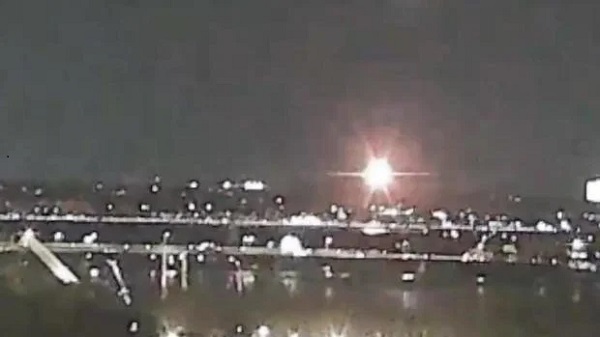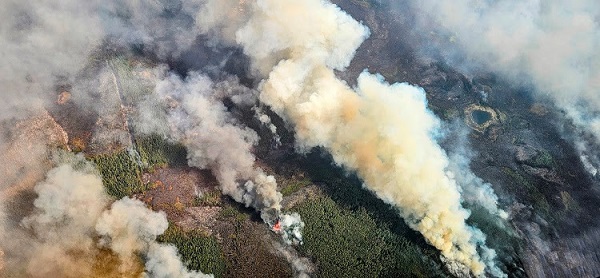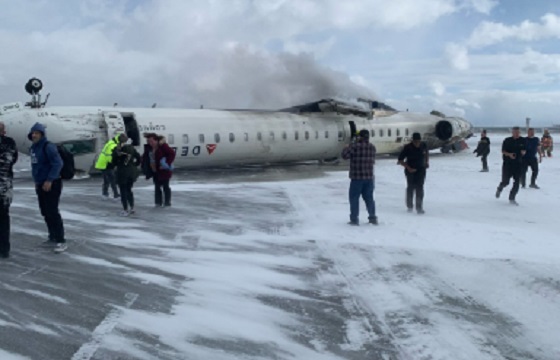Disaster
Army Black Hawk Was On Training Flight

Squadron primarily used for transporting VIPs around D.C. was apparently familiarizing new pilot with area.
Wednesday night, shortly before 9pm ET, an American Airlines flight carrying 64 people was on its final approach to Ronald Reagan Washington National Airport when it collided with an Army helicopter with three soldiers on board, about 400 feet off the ground, killing everyone on both aircraft.
The Sikorsky UH-60 Black Hawk had departed from Fort Belvoir in Virginia with a flight path that cut directly across the flight path of Reagan National Airport
This final approach is probably the most carefully controlled in the world, as it it lies three miles south of the White House and the Capitol.
According to various media reports, military aircraft frequently train in the congested airspace around D.C. for “familiarization and continuity of government planning.”
Less than 30 seconds before the crash, an air traffic controller asked the helicopter, whose callsign was registered as PAT25, if he could see the arriving plane.
‘PAT25 do you see a CRJ? PAT 25 pass behind the CRJ,’ the air traffic controller said. A few seconds later, a fireball erupted in the night sky above Washington DC as the two aircraft collided.
Secretary of Defense Pete Hegseth issued the following statement on X:
It seems that Blackhawks from the 12th Aviation Battalion out of Davison Army Airfield are primarily used for shuttling VIPs around the D.C. area. The following appears to be a helicopter from this battalion.
On the face of it, it strikes me as very imprudent to conduct training flights at night that cross the final approach to Reagan D.C. To me, the word “training” suggests a potential for making errors that an instructor is called upon to correct.
It also strikes me as very strange that Army Blackhawk helicopters operating in this airspace at night are not required to operate with bright external lights, especially when crossing the final approach to Reagan D.C.
Finally, though it’s nothing more than a vague intuition, it seems to me that there is something very strange about this disaster and the timing of it. I wonder if, for some reason, risk management of such training activities was impaired.
Alberta
New teams will boost Alberta wildfire preparedness

Alberta’s government is investing almost $7 million to create six new Wildland Urban Interface (WUI) teams to protect communities at risk from wildfires.
In response to increased wildfire activity in recent years, Alberta’s government is taking action to better safeguard communities and strengthen the way emergencies are responded to. This includes record investments in equipment and personnel, as well as targeted strategies to enhance local firefighting capacity, readiness and resilience.
Alberta’s government is responding proactively to wildfire threats by funding six local fire departments through the Wildland Urban Interface Program to boost wildfire preparedness and response capabilities. This initiative quadruples the number of existing Wildland Urban Interface teams, ensuring a stronger, more coordinated effort to protect communities from potential wildfire emergencies.
“Alberta’s government continues to make critical investments to strengthen the way emergencies are handled. We are effectively quadrupling the number of Wildland Urban Interface teams in Alberta to ensure the safety of Albertans’ businesses, neighbourhoods and critical infrastructure during wildfires.”
“Firefighting teams like this can truly make the difference when it comes to protecting Alberta’s communities. Having more Wildland Urban Interface teams improves our capabilities and adaptability when our wildland firefighting teams are fighting fires across Alberta.”
The Wildland Urban Interface Program targets zones where developments such as homes, farms or industrial sites border or mix with natural vegetation at risk from wildfire. Fires that occur in these transitional areas between forests, grasslands and populated communities are often challenging and demand the expertise of both wildland and structural firefighters. Wildland Urban Interface teams consist of firefighters who have the specialized training and equipment needed to respond to wildfires that enter a community or where developed areas meet wildland areas.
This program is a partnership between the provincial government and local authority fire services and includes funding from Natural Resources Canada. The province is responsible for coordination and funding, while local fire departments contribute personnel, firefighting equipment and resources. The expansion of this program will enhance the overall deployment of specialized resources across the province and improve municipal fire service capacity through additional training and technical support.
“The announcement of almost $7 million in funding to quadruple the number of Wildland Urban Interface teams will strengthen Alberta’s wildfire preparedness and significantly improve safety for Strathmore residents. As the local MLA, I am proud to support the growth of these versatile teams, which are deployed across the province to support municipalities like ours and reinforce our local firefighting capabilities.”
“Strathmore’s firefighters have repeatedly shown their skill, commitment and leadership during emergency deployments. Participation in the WUI Program allows us to strengthen those capabilities, enhance regional partnerships, and help build a sustainable response model for our community and province.”
Each new Wildland Urban Interface Team will receive $1.09 million over two to three years for personnel costs, administrative support, equipment, maintenance and travel costs to help develop and expand the program’s training and operational capacity.
The local authorities receiving funding are:
- Town of Strathmore
- Town of Hinton
- Town of Slave Lake
- Lac La Biche County
- Kee Tas Kee Now Tribal Council
- Kananaskis Improvement District
There are two existing teams based out of Clearwater County and the Town of High Level.
Quick facts
- Funding for the Town of Hinton, Town of Slave Lake, Lac La Biche County and Kee Tas Kee Now Tribal Council is shared equally between Natural Resources Canada and Alberta Forestry and Parks.
- Funding for the teams based in the Town of Strathmore and Kananaskis Improvement District will be provided by the Alberta Emergency Management Agency.
- Each team will receive a total of $1.09 million for a combined total of close to $7 million.
Related information
Disaster
Delta flight crashes and flips upside-down at Toronto airport as 3 are left critically injured

Quick Hit:
A Delta Air Lines plane crash-landed and flipped upside-down at Toronto Pearson International Airport on Monday, leaving three passengers— including a child— critically injured. The incident occurred just before 3 p.m. after the aircraft took off from Minneapolis earlier in the day. Images from the scene show the plane severely damaged, with emergency crews rushing to assist passengers.
BREAKING- Toronto had a Delta flight flipped upside down. I got these photos from a friend on the plane. He’s okay. Minnesota to Toronto. pic.twitter.com/DeSoYAlsVo
— Kellie Meyer (@KellieMeyerNews) February 17, 2025
Key Details:
- The flight, identified as Delta Flight 4819, departed from Minneapolis at 11:47 a.m. before crash-landing in Toronto.
- At least eight people were reported injured, with three in critical condition, including a child and a man in his 60s.
- The aircraft, a Bombardier CRJ-900LR, was flipped upside-down on the runway, with one wing crumpled and the tail section partially sheared off.
Diving Deeper:
Emergency responders rushed to Toronto Pearson International Airport on Monday afternoon after Delta Flight 4819 suffered a crash landing, flipping upside-down on the snowy runway. Images from the scene depict a harrowing sight— the overturned aircraft smoldering, with dazed passengers evacuating.
According to CP24 News, eight people sustained injuries in the crash, three of whom were transported to separate hospitals in critical condition, including a pediatric patient. The Peel Regional Police confirmed that while most passengers made it out unharmed, authorities remained on-site to assess the full extent of the injuries and damage.
Passenger John Nelson captured the immediate aftermath on video, posting to Facebook: “We’re in Toronto. We just landed. Our plane crashed, it’s upside-down. Fire department is on site. Most people appear to be OK. We’re all getting off.” The footage shows emergency personnel navigating the snowy conditions to reach the aircraft and assist those on board.
Toronto Pearson officials confirmed on X (formerly Twitter) that all passengers and crew were accounted for, while the Association of Flight Attendants union stated that no fatalities had been reported. However, airport operations were briefly suspended in the wake of the incident, with arrivals and departures temporarily halted.
The crash comes after a weekend winter storm dumped nearly nine inches of snow on Toronto, prompting airport crews to work overnight to clear runways. Investigators will now seek to determine whether weather conditions or mechanical failure played a role in the crash. This marks the most serious commercial aviation incident since the January 29 collision at Ronald Reagan National Airport involving an Army Black Hawk helicopter and an American Airlines flight.
-

 International1 day ago
International1 day agoIsrael’s Decapitation Strike on Iran Reverberates Across Global Flashpoints
-

 Business2 days ago
Business2 days agoTrump: ‘Changes are coming’ to aggressive immigration policy after business complaints
-

 illegal immigration2 days ago
illegal immigration2 days agoLA protests continue as judge pulls back CA National Guard ahead of ‘No Kings Day’
-

 conflict2 days ago
conflict2 days agoIsrael strikes Iran, targeting nuclear sites; U.S. not involved in attack
-

 Alberta1 day ago
Alberta1 day agoPunishing Alberta Oil Production: The Divisive Effect of Policies For Carney’s “Decarbonized Oil”
-

 Alberta1 day ago
Alberta1 day agoAlberta Premier Danielle Smith Discusses Moving Energy Forward at the Global Energy Show in Calgary
-

 Fraser Institute1 day ago
Fraser Institute1 day agoLong waits for health care hit Canadians in their pocketbooks
-

 conflict1 day ago
conflict1 day agoIran nuclear talks were ‘coordinated deception’ between US and Israel: report










